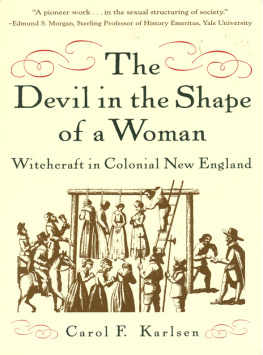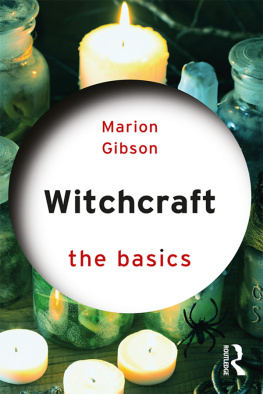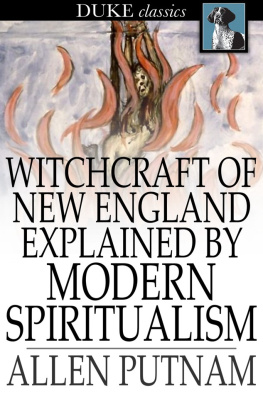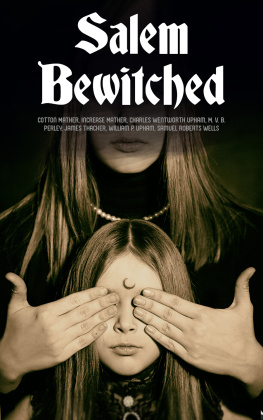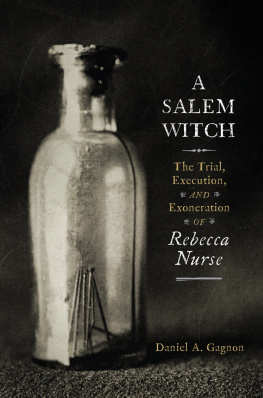

T EN YEARS HAVE GONE BY since this book was first published. More than twenty years have passed since I began the research upon which it is based. However I look at it, I have lived a long time with the women whose stories you have just heard.
Initially, Abigail Faulkner, Eunice Cole, Ann Hibbens, Elizabeth Knapp, and the scores of other women written about here were simply names recorded in documents that were somehow preserved, their lives almost wholly hidden from view by three centuries of disinterest and neglect. Slowly, painstakingly, I put together pieces of those lives, identifying accused witches parents, recording the births of their children and the marriages and deaths of their siblings, searching out church records to see if possessed females were godly and court records to see whom if anyone they had offended. Occasionally, I had a really good day, when one document led to another, and then another, and so on until I could glimpse a small episode or series of events in an individual life. More often, I came away with seemingly unconnected evidence, which only gradually took recognizable shape. Not until I could piece together what seemed like many tiny sections of a gigantic puzzle did the patterns that linked these womens lives even begin to emerge.
To some of you, my early research process will sound familiar. Combining the methods of family reconstitution and collective biography, so in vogue among historians when I started work on this book, I saw my first task as searching out every mention of accused and possessed women that I could locate in the surviving records (and any concerning their supporters and detractors). I doubted that accused witches were simply scapegoats for social tensions that had little or nothing to do with them or their position in colonial society, as many previous interpretations had suggested; but in the mid-1970s, so little research had been done on women and gender in early America that I knew only the most thorough reconstruction of individual histories would allow me to grasp why most accused witches and possessed persons in New England were female. Much more remained to be done, of course, to figure out where both women and witchcraft fit in Puritan theology and social structure. But looking back so many years later, I see how much the strength of my book lies in bringing these womens stories to light.
I did not get it all right, as subsequent scholarship shows. Alice Parker, it turns out, was not the daughter of Giles Corey, as I suspected, and Mary Barnes was not poor. Nor was Anne Hutchinson a midwife; rather, as Governor John Winthrop noted, she was simply a woman very helpfull in the times of child-birth, and other occasions of bodily infirmities. While I continue to see womens involvement in childbirth and medical care as a part of the larger witchcraft story in New England, midwives were not as vulnerable to witchcraft suspicion as I had thought.
Were I to redo the book, more substantial changes are called for. For example, I would clarify at the start why I frequently used the term witches instead of accused witches to describe the targets of accusations. Although my research did not support the assumption that women accused of witchcraft actually practiced it, to avoid confusing readers with my usage, I would devote some attention to my conviction that seventeenth-century religious beliefs need to be taken on their own terms if we are to understand why New Englanders so often presumed their female enemies were witches. In addition, I would more thoroughly research the links between witchcraft, race formation, and colonialism. Although important work has been done in this area, especially in the last few years, more is essential, especially on the relationship between English colonists and their indigenous neighbors and New Englanders belief that Native Americans were devils in disguise. The links between the demonization of women and other difficult-to-subordinate groups, moreover, remain largely unexamined.
Responses to The Devil in the Shape of a Woman have varied widely. Most gratifying has been the enthusiasm of college and university students who have read the book in their undergraduate and graduate classes and faculty members who assign it in their history, womens studies, or other courses. Most of these respondents are women, and, not surprisingly, they talk most appreciatively about the books life histories, particularly how they illuminate the significance of gender in witchcraft cases. I have heard both the anger they feel about the distortions of the past created by the lack of attention to gender and the empowerment they find in beginning to understand both the relationship between women and witchcraft and the reasons womens history has so long been ignored or marginalized. This response is particularly vivid among students, whose knowledge of New England witchcraft has come largely from Arthur Millers The Crucible and other fictionalized accounts of the Salem outbreak of 1692.
With a few exceptions, published responsesin both popular and scholarly publicationshave also been overwhelmingly positive. Since many more men than women have reviewed the book, its importance for womens history has only occasionally been assessed, but it has generally been recognized as a major contribution to the historical literature on witchcraft and early American society. Appreciation of its long-term significance is also apparent when measured by the extent to which it has influenced subsequent studies of witchcraft and womens history. Some reactions, though, have been puzzling enough to warrant attention.
If the witchcraft studies of both Europe and New England that have appeared since my book was published have drawn extensively on my work, my gender analysis has been ignored, trivialized, or obliquely challenged in several books and articles, as well as in academic and public discussion sparked by the three hundredth anniversary of the 1692 Salem witchcraft outbreak. I have come to see this reaction as a form of silencing, a way of deflecting and diminishing the influence of feminist scholarship, and not simply my own. As Elspeth Whitney recently pointed out, several overt and covert strategies have been deployed by witchcraft scholars to avoid according gender the place it deserves in the history of witchcraft.
Parts of my own argument have been more openly questioned, most significantly my portrayals of accused witches and possessed persons. As I argue in the book, unless one accepts the views of their enemies and detractors, little evidence can be found for accused witches reputation among both scholarly and popular writers as difficult, turbulent, contentious, opinionated, unreasonable, unpleasant, shrewish, envious, easily offended, or malicious. Nor do I put much credence in views of possessed females as lying, manipulative, twisted, hysterical, merciless, mentally ill, childish, whorish, or demonic. If a saintly Rebecca Nurse or an innocent Betty Parris occasionally relieves the monotony of these highly derogatory portraits, and if no one author holds all of these views, these recurrent characterizations still profoundly shape how most of these women are remembered. Such constructions have little do do with these women themselves, I find, and everything to do with past and present assumptions about how women ought to behave. I suspect that the reluctance to let go of bad character or deviant personality interpretations in light of these womens life histories is related to the deeply embedded tendency in our society to hold women ultimately responsible for violence committed against them.
Next page
